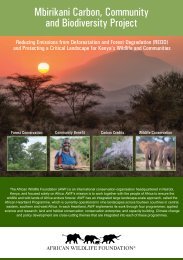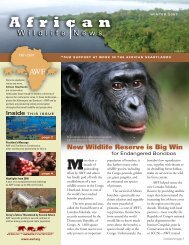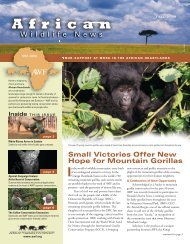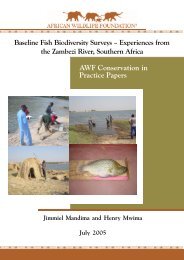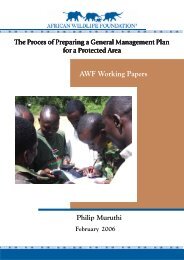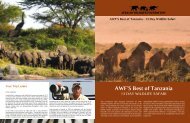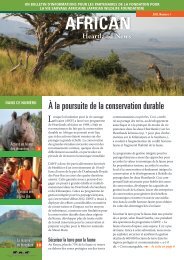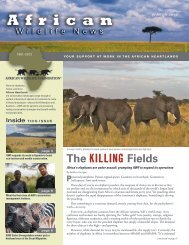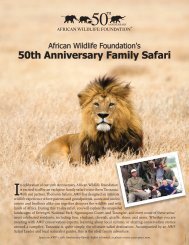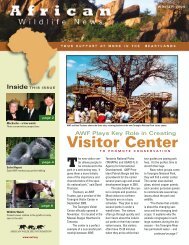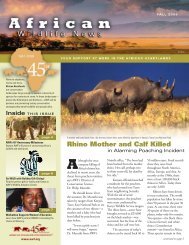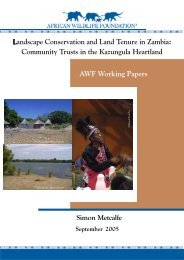Download (English) - African Wildlife Foundation
Download (English) - African Wildlife Foundation
Download (English) - African Wildlife Foundation
Create successful ePaper yourself
Turn your PDF publications into a flip-book with our unique Google optimized e-Paper software.
A NEWSLETTER FOR PARTNERS OF THE AFRICAN WILDLIFE FOUNDATION<br />
<strong>African</strong><br />
Heartland News<br />
2013, Issue 1<br />
In this issue<br />
Actions on Rhinos<br />
Considering Jiko Stoves<br />
Biosphere Reserve<br />
3<br />
8<br />
10<br />
In Pursuit of Sustainable Conservation<br />
When the <strong>African</strong> <strong>Wildlife</strong> <strong>Foundation</strong><br />
(AWF) launched its <strong>African</strong> Heartlands<br />
programme in 1998, it was in recognition<br />
of the fact that lasting conservation in<br />
Africa could only be achieved if actions<br />
were pursued at the large-landscape level.<br />
Large-landscape conservation, however,<br />
often requires similarly expansive funding—<br />
something that is not easy to come by,<br />
particularly during a global economic<br />
recession.<br />
AWF has thus been particularly fortunate to<br />
have a €10 million investment from the Royal<br />
Netherlands Embassy over the past four years.<br />
This grant enabled us to engage in a largescale,<br />
multipronged project in our Samburu<br />
and Kilimanjaro Heartlands. Through the<br />
Integrated Management Programme for the<br />
Kenyan Landscapes, which ended early in<br />
2012, AWF was able to achieve substantial<br />
conservation and livelihood impact, build<br />
a foundation for sustainable conservation<br />
in two areas in Kenya, develop more than<br />
30 innovative conservation work tools and<br />
complete a plan for the Masai Mara National<br />
Reserve.<br />
Securing land for wildlife<br />
In Kenya, more than 75 percent of wildlife is<br />
found outside protected areas on community<br />
and private lands. This, combined with land<br />
subdivision, unregulated development and<br />
the practice of pastoralist lifestyles in both<br />
Heartlands (for more on Kilimanjaro and<br />
Samburu, see “The Kenyan Heartlands” on<br />
p.7), has led to increased human–wildlife<br />
conflict and fragmented habitat for wildlife.<br />
The Integrated Management Programme<br />
for the Kenyan Landscapes piloted<br />
approaches to increase the economic value<br />
of wildlife for landowners, increase local<br />
support for conservation and ultimately<br />
integrate landscape-level conservation and<br />
development across the two Heartlands. This<br />
included helping to establish conservancies,<br />
develop capacity for local management of<br />
wildlife, launch conservation enterprises to<br />
generate economic benefits, and implement<br />
human–wildlife conflict mitigation to reduce<br />
the costs of wildlife damage.<br />
Securing land for wildlife was a priority for<br />
this project, according to Daudi Sumba, vice<br />
president for programme operations at AWF.<br />
“<strong>Wildlife</strong> needs space—without space, there<br />
is no wildlife. Through this grant, we were<br />
able to leverage, secure and improve the<br />
management of more than 600,000 hectares<br />
of land in protected and community areas,” he<br />
said. “That’s significant.” continued on page 6
2<br />
2 <strong>African</strong> Heartland News<br />
<strong>African</strong> Heartland News<br />
AWF Senior Staff<br />
Patrick Bergin, Ph.D.<br />
CEO<br />
Kenya/United States<br />
Daudi Sumba<br />
Vice President for<br />
Programme Operations<br />
Kenya<br />
Joanna Elliott<br />
Vice President<br />
for Programme Design<br />
United Kingdom<br />
Kathleen Fitzgerald<br />
Vice President<br />
for Conservation Strategy<br />
Kenya/South Africa<br />
Jef Dupain<br />
Director, Great Apes Program<br />
Kenya<br />
Dave Loubser<br />
Programme Director, Climate Change<br />
Kenya<br />
Brian McBrearity<br />
Programme Director,<br />
Conservation Enterprise<br />
Kenya<br />
Philip Muruthi<br />
Senior Director,<br />
Conservation Science<br />
Kenya<br />
Charly Facheux<br />
Director, Congo Heartland<br />
Democratic Republic of Congo<br />
Benson Lengalen<br />
Coordinator, Samburu Heartland<br />
Kenya<br />
Pascal Rouamba<br />
Manager, Regional Parc W Heartland<br />
Burkina Faso<br />
John Salehe<br />
Director, Maasai Steppe<br />
Heartland<br />
Tanzania<br />
Nasson Tembo<br />
Director, Kazungula Heartland<br />
Zambia<br />
Fiesta Warinwa<br />
Director, Kilimanjaro Heartland<br />
Kenya<br />
<strong>African</strong> Heartland News is published<br />
three times a year, thanks to funding<br />
support from the Royal Netherlands<br />
Embassy.<br />
© 2013 <strong>African</strong> <strong>Wildlife</strong> <strong>Foundation</strong><br />
P.O. Box 48177, 0100<br />
Nairobi, Kenya<br />
Tel: +254 20 2710367<br />
Fax: +254 20 2710372<br />
africanwildlife@awfke.org<br />
A Long-Term Commitment<br />
Heartland conservation is a complex<br />
undertaking at all levels, from the<br />
ecological dynamics underpinning ecosystem<br />
functions to the interactions between social,<br />
cultural, economic and political forces that<br />
drive and affect them. Human needs within<br />
a particular landscape are diverse and those<br />
within and between communities are often<br />
unaligned—some community members want<br />
natural products out of the system, others are<br />
looking for farmlands and yet others rely on<br />
livestock and even wildlife for their livelihoods.<br />
There are divergent political interests and<br />
gender differences that define ways in which<br />
people interact with their resources. <strong>Wildlife</strong><br />
too has varied resource requirements whose<br />
availability may vary daily or seasonally; often<br />
species have to move over large areas to track<br />
these seasonal resources, exacerbating areas of<br />
serious human and wildlife conflict.<br />
To bring these together into a coherent<br />
program that delivers both conservation and<br />
socioeconomic benefits requires a number of<br />
critical success factors. These include accessing<br />
a mix of disciplines and skills; building strong<br />
relationships with multiple stakeholders,<br />
especially local communities, local and national<br />
governments, and private sector partners; as<br />
well as a solid understanding of the dynamics<br />
and interactions listed above—and all built<br />
on good science to underpin management<br />
decisions.<br />
Making a long-term commitment to specific<br />
Heartlands is critical, which requires us to find<br />
significant and sustained funding over a period<br />
of years to ensure we can design, develop,<br />
test and implement an integrated package of<br />
investments that will help deliver sustainable<br />
conservation and economic outcomes at<br />
scale. That is why long-term relationships<br />
with development partners such as the Dutch<br />
government (see our cover story), U.S. Agency<br />
for International Development (USAID) and<br />
others are critical to our success.<br />
As we begin 2013, AWF would like to announce<br />
the launch of such a partnership, with USAID<br />
Uganda. The “Tourism for Biodiversity”<br />
(T4B) program is a four-year, US$10 million<br />
commitment. AWF will work with local<br />
partners to leverage the knowledge gained<br />
through previous work with Uganda’s naturebased<br />
tourism industry (see p. 4) to make a<br />
significant contribution to conservation and<br />
communities in this country.<br />
It is our long-term commitment to Africa that<br />
is helping AWF and our partners deliver the<br />
results shared here, to best ensure that Africa’s<br />
wildlife and wild lands endure for the benefit of<br />
Africa’s people and the world at large.<br />
Daudi Sumba<br />
Vice President of Programme Operations<br />
AWF Thanks Helen Gichohi<br />
AWF is sincerely grateful to Helen Gichohi for<br />
her many years of service and dedication to our<br />
organisation and to <strong>African</strong> conservation. As AWF<br />
president, Helen provided critical programme<br />
leadership and was a strong and eloquent voice<br />
in framing the conservation policy debate across<br />
the continent. Helen leaves AWF for a new<br />
career opportunity to help guide the economic<br />
development of her beloved Kenya. Stepping down<br />
from her presidential post with AWF, she will remain<br />
involved as a member of AWF’s board of trustees.<br />
All of us at AWF wish Helen the very best in her<br />
future endeavours, and we look forward to her<br />
continued input on how to best ensure that Africa’s<br />
wildlife and wild lands endure for the benefit of<br />
Africa’s people and the world at large.
AWF has long supported rhino conservation projects.<br />
Following the emergency Rhino Summit hosted by AWF<br />
and Kenya <strong>Wildlife</strong> Service (KWS) in April 2012 (see “An<br />
Africa Solution to Rhino Poaching,” <strong>African</strong> Heartland News<br />
2012, Issue 2), AWF considered additional actions to help<br />
ensure the long-term survival of the <strong>African</strong> black and white<br />
rhino. Following are just some of the initial steps AWF has<br />
taken.<br />
Reducing Demand<br />
In an effort to reduce demand, AWF entered into a partnership<br />
with NGO WildAid to conduct a public awareness campaign<br />
in China. China is one of the main consumers of rhino horn.<br />
The campaign will include a series of high-impact public<br />
service announcements and advertisements featuring leading<br />
Asian celebrities, educating consumers about how their use<br />
and consumption of rhino horn leads to the illegal poaching<br />
of rhinos. Already the partnership has produced a billboard<br />
featuring former NBA player Yao Ming and a video featuring<br />
infographics about the poaching problem. More is expected<br />
going forward.<br />
Caught on Camera<br />
AWF donated 20 camera traps, along with metal casings, to<br />
KWS for rhino monitoring and surveillance in Ngulia Rhino<br />
Sanctuary, a fenced “safe” area for rhinos in Tsavo West<br />
National Park, and the Intensive Protection Zone (IPZ), an<br />
unfenced but heavily protected area to which many of the<br />
2013, Issue 1 3<br />
Following Summit, AWF Takes Action on Rhinos<br />
Ngulia rhinos are relocated. These camera traps allow KWS<br />
to more easily locate and protect the Eastern black rhinos<br />
residing in the 103-sq.-km sanctuary and IPZ. (The cameras<br />
also recently captured poachers in action—KWS has reportedly<br />
submitted the photography to police for suspect identification.)<br />
Sniffing Out Illegal Trafficking<br />
KWS deploys a canine unit that detects wildlife products<br />
at international airports, but with only six dogs, the unit is<br />
currently understaffed. As a result, dogs and their handlers<br />
have to work 12-hour daily shifts, according to KWS canine<br />
master Charles Rono. He noted the ideal scenario would be to<br />
have units working six-hour shifts.<br />
AWF will therefore soon fund up to 8 additional sniffer<br />
dogs—which are trained to detect elephant ivory, rhino horn<br />
and weapons with greater than 90 percent accuracy—and 10<br />
handlers. The dogs will be deployed to an additional airport<br />
and Kenya’s main harbor, Kilindini.<br />
Save Stabilization<br />
Zimbabwe has the fourth-largest population of black rhino in<br />
the world, but since 2006, 89 percent of all black rhino losses<br />
on the continent have occurred in the country. Supporting<br />
anti-poaching units in Save Valley Conservancy, Zimbabwe’s<br />
largest—which has 100 Southern black and 35 white rhinos—<br />
provides a feasible way of stabilizing and eventually increasing<br />
the continent’s critically endangered black rhino population. m<br />
AWF has supplemented its usual rhino work<br />
with additional efforts to stem poaching.<br />
Billy Dodson
4<br />
Philip Muruthi<br />
2 <strong>African</strong> Heartland News<br />
New Tool to Evaluate<br />
Conservation Enterprises<br />
By Giles Davies Investment manager, <strong>African</strong><br />
<strong>Wildlife</strong> Capital<br />
Africa-based conservation tourism projects are complex<br />
and have their own specific dynamics. It can nevertheless<br />
be helpful to have guidelines by which to evaluate the<br />
conservation impacts of such an enterprise. Understanding<br />
this, AWF developed a conservation tourism evaluation<br />
framework through the Uganda STAR II project.<br />
The framework rates a conservation enterprise on nine<br />
attributes using a simple traffic light system (whereby an<br />
attribute being positively represented in the conservation<br />
enterprise receives a green, for example). Attributes included:<br />
• Conservation relevance,<br />
• Social impact potential,<br />
• Enabling environment and<br />
• Benefits management, among others.<br />
Evaluation tool<br />
While the framework primarily serves as a due-diligence<br />
tool for AWF and its subsidiary, <strong>African</strong> <strong>Wildlife</strong> Capital, to<br />
appraise new opportunities, it has already provided value as<br />
an evaluation tool for existing enterprises. AWF used this<br />
framework to evaluate five conservation tourism enterprises<br />
in Uganda and found a number of compelling themes. These<br />
included:<br />
• The need to develop legal institutions through which<br />
benefits to local communities from tourism enterprises<br />
can be transparently, fairly and meaningfully managed;<br />
and<br />
• The need for both enterprises and local livelihoods to be<br />
based upon target conservation values.<br />
Findings from the Uganda STAR II process will no doubt<br />
be relevant as AWF launches its new programme work in<br />
Uganda (see “A Long-Term Commitment” on p. 2). m<br />
<strong>African</strong> Heartland News<br />
AWF Lays <strong>Foundation</strong><br />
By Etotépé A. Sogbohossou<br />
Straddling Benin, Burkina Faso and Niger,<br />
the W–Arly–Pendjari (WAP) ecosystem<br />
is one of the largest transboundary protected<br />
ecosystems in West Africa. This region is home<br />
to West Africa’s last major population of savanna<br />
elephant—numbering at around 4,950 as of a<br />
2003 census—and the highly endangered West<br />
<strong>African</strong> giraffe, of which only 250 remain in the<br />
wild.<br />
This region is home<br />
to West Africa’s last<br />
major population<br />
of savanna elephant<br />
The main factor threatening the future of<br />
these animals is habitat conversion and<br />
degradation. With unplanned settlement<br />
and agriculture increasingly surrounding the<br />
Sahelian ecosystem’s protected areas, many<br />
migration corridors essential for the unimpeded<br />
movement of elephant and the West <strong>African</strong><br />
giraffe are being blocked and critical habitat<br />
being lost, jeopardizing these species and the<br />
rich biodiversity of this unique ecological<br />
landscape.<br />
Under two grants—from the Swedish Postcode<br />
Lottery <strong>Foundation</strong> and the MAVA <strong>Foundation</strong><br />
for Nature—AWF has begun working with<br />
local partners and authorities to monitor and<br />
map elephant and giraffe movements across the<br />
landscape to improve our understanding of their<br />
habitat requirements and the types and levels<br />
of threat they face, information that is essential<br />
to designing programs to improve wildlife<br />
protection, habitat conservation and land-use<br />
planning in the region.<br />
Partners for elephant monitoring include park<br />
authorities in Burkina Faso and Benin, local<br />
associations, and universities in those two<br />
countries. AWF is working with Niger <strong>Wildlife</strong><br />
Directorate and the local guides association,<br />
Association for the Valorisation of Ecotourism<br />
in Niger (AVEN), plus universities in Niger. For<br />
all activities, AWF is paying special attention<br />
to potential linkages with other conservation
2013, Issue 1 5<br />
for Elephant, Giraffe Conservation in West Africa<br />
Ecologist, Regional Parc W Heartland<br />
work that is under design or implementation by other<br />
stakeholders working in the landscape, especially the<br />
European Union’s Programme d’Appui aux Parcs de<br />
l’Entente and WAP regional programs.<br />
Initial efforts<br />
AWF has supplied monitoring equipment—composed<br />
of GPS units, cameras and binoculars—to the<br />
rangers of the Pendjari Biosphere Reserve in Benin<br />
and Parc W Burkina, as well as the AVEN giraffe<br />
guides. Pendjari and Parc W rangers received a<br />
short training on how to use the equipment,<br />
and the effective monitoring of<br />
elephants started in Pendjari in<br />
June and in Parc W Burkina in July.<br />
During their patrols, they collect<br />
and record data on elephant groups<br />
and habitats. Forms are designed to<br />
capture information about herd size and<br />
composition, such as sex ratio and number of<br />
adults and sub-adults.<br />
AWF is working with the Ministries of Environment<br />
in Burkina and Benin to get authorisation on<br />
elephant collaring and will hopefully soon begin<br />
planning with the field staff and veterinarian. We are<br />
aiming to conduct the collaring in Q1 or Q2 of the 2013<br />
calendar year.<br />
have been planted, mostly by local women. Additional local<br />
people will soon be trained in nursery plant production.<br />
Challenges<br />
Initial efforts on elephant and giraffe conservation have not<br />
been without their challenges. For example, only Pendjari is<br />
collecting data on elephant currently, because the rainy season<br />
and limited means of transportation have<br />
temporarily halted all patrolling in W<br />
Burkina. With giraffe conservation,<br />
there were some delays in the<br />
organising of a national workshop on<br />
developing a giraffe conservation<br />
action plan in Niger. AWF<br />
is hoping to facilitate such a<br />
gathering of stakeholders in<br />
coming months.<br />
Despite these challenges, we are<br />
excited about the projects that<br />
are underway and confident that<br />
these efforts will allow for greater<br />
conservation gains in the future in<br />
the WAP ecosystem. m<br />
AWF has also contacted the University of Abomey–<br />
Calavi in Benin and the University of Ougadougou in<br />
Burkina Faso to seek students to help monitor human–<br />
elephant conflicts as part of their training and experience<br />
provision in the field. One student has already surveyed<br />
the conflicts around W Burkina, and the data is being<br />
analysed. Conflicts are a great problem in the area: Local<br />
people are feeling abandoned by the government, which<br />
communities say has not stepped in to help mitigate the<br />
challenges, especially the losses of crops and livestock.<br />
Meanwhile, AWF has prepared a detailed giraffemonitoring<br />
program with wildlife authorities and park<br />
staff. Giraffe guides received a short training and started<br />
in June with the monitoring of individual giraffes. Every<br />
day, they follow a handful of giraffes and record data on<br />
their movements in the ecosystem, within both their core<br />
and extended ranges.<br />
Together with the Niger <strong>Wildlife</strong> Authority rangers and<br />
AVEN guides, AWF identified priority degraded areas in<br />
the core giraffe range for restoration. About 4,890 plants
6<br />
2 <strong>African</strong> Heartland News<br />
<strong>African</strong> Heartland News<br />
continued from page 1<br />
Among the activities that AWF pursued were the<br />
development of a joint management plan for Samburu,<br />
Buffalo Springs and Shaba National Reserves in the<br />
Samburu Heartland, leading to improvement in the<br />
conservation and management of the three reserves (and for<br />
the first time as a single unit for conservation and tourism).<br />
The Protected Area Planning Framework (PAPF) was used<br />
as the principle planning tool and is under use in other<br />
reserves owned by county councils and Kenya <strong>Wildlife</strong><br />
Service. AWF also helped with the renovation of 19 rangers’<br />
houses at Shaba and Buffalo Spring to improve monitoring<br />
and patrols (see “AWF Improves Infrastructure at Buffalo<br />
Springs,” <strong>African</strong> Heartland News 2012, Issue 1). Reserve<br />
revenues have subsequently increased, according to Benson<br />
Lengalen, former Samburu Heartland<br />
natural resources management officer and<br />
now Heartland coordinator.<br />
In Kilimanjaro Heartland, AWF launched<br />
an innovative land lease program whereby<br />
AWF pays landowners an annual fee to<br />
keep their land open for wildlife coming<br />
out of Amboseli National Park to Kimana<br />
and Tsavo National Park further east.<br />
The process led to the creation of three<br />
conservancies—Osupuko, Kilitome<br />
and Nailepu—and established a wildlife<br />
corridor to the east of the park. In Kilitome Conservancy,<br />
the high-end Tawi Lodge has agreed to take over the landlease<br />
payments, presenting<br />
a potential solution for<br />
ensuring sustainability of<br />
the land-lease program.<br />
million each year, providing incentives for the community to<br />
better manage this area for wildlife.<br />
According to AWF Vice President for Conservation<br />
Strategy Kathleen Fitzgerald, “Connected land units that are<br />
appropriately zoned for various uses allow communities to<br />
better adapt to impacts of climate change, which in many<br />
cases has serious consequences on livelihoods and poverties.”<br />
Of the 661,955 hectares of land leveraged for conservation,<br />
350,165 hectares—44 percent—were set aside for<br />
conservation in 20 community areas. “That communities<br />
have chosen to set aside this much land for conservation<br />
shows that community-based conservation has been<br />
accepted as a legitimate land-use<br />
option for local socioeconomic<br />
The programme<br />
piloted approaches<br />
to increase the<br />
economic value<br />
of wildlife<br />
development and sustainability,”<br />
remarked Fiesta Warinwa,<br />
Kilimanjaro Heartland director.<br />
2 key elements<br />
AWF recognised that sustaining<br />
conservation, however, required<br />
two key elements: the existence of<br />
businesses that provide a continual<br />
influx of revenue and a certain level<br />
of capacity among the local population. “One of our biggest<br />
lessons learned is that you must secure space for wildlife<br />
through a combination of natural resource planning and<br />
local capacity building to manage the land and wildlife,”<br />
Sumba explained. “You must give wildlife value in the eyes of<br />
the people.”<br />
Amy Barriale<br />
AWF field staff additionally<br />
worked with representatives<br />
of the Olgulului Group<br />
Ranch, which surrounds<br />
Amboseli, to create a<br />
community-led land-use plan.<br />
Specific areas of the ranch<br />
were designated for wildlife<br />
conservation, combined<br />
pastoralism and<br />
wildlife, settlements,<br />
and agriculture,<br />
streamlining land<br />
use and creating<br />
four conservancies<br />
in the process. Once<br />
fully implemented,<br />
the land-use plan is<br />
projected to generate<br />
increased revenues<br />
of up to US$1.2<br />
AWF therefore supported the establishment of 12<br />
conservation enterprises and 27 natural resource<br />
management institutions during the four-year grant. These<br />
ranged from women’s groups that improved livelihoods,<br />
to livestock market access companies, to a bioenterprise<br />
program focusing on business opportunities in honey, aloes<br />
and wild botanical plants. With inputs from Kenyan law firm<br />
Coulson Harney, AWF’s Samburu Heartland staff is helping<br />
to resolve some key challenges between the community and<br />
private sector partner in Ol Lentille Lodge and to restructure<br />
the partnership between the community and private sector<br />
partner in Lumo Tented Lodge. The aim is to arrange new<br />
terms that generate higher incomes for the community.<br />
During the life of the grant, enterprises generated more<br />
than US$2 million in income for communities and directly<br />
benefited 33,835 people in Samburu and Kilimanjaro<br />
Heartlands. AWF’s use of money transfer, and the<br />
requirement for beneficiaries to open bank accounts to<br />
ensure direct benefit-sharing, was a welcome departure<br />
from the communal benefit sharing arrangements that<br />
Scouts are effective in addressing threats and<br />
providing wildlife security.
2013, Issue 1 7<br />
historically had provided opportunities for corruption and<br />
mismanagement. More than 4,200 individuals were trained<br />
in a wide range of skills—including livestock management,<br />
ecological monitoring, scout and security training, and basic<br />
financial management and governance—improving their<br />
capacity for effective natural resources management and<br />
livelihood diversification.<br />
of water and expand its focus from single enterprises to<br />
value-chain enterprises, which produces greater benefits<br />
to communities. The grant will also allow AWF to conduct<br />
systematic restoration efforts in the Mau Forest, including<br />
tree replanting, watershed protection, water harvesting<br />
and more.<br />
AWF faced a number of<br />
challenges during the life of<br />
the Integrated Management<br />
Programme for the Kenyan<br />
Landscapes, including a<br />
drought in 2009 that resulted<br />
in massive livestock and<br />
wildlife deaths. “Extreme drought really impacted pastoral<br />
livelihoods and threatened the well-being of some species<br />
of wildlife,” observed Philip Muruthi, AWF’s senior director<br />
of conservation science. AWF had channeled some of<br />
the funding for conserving a number of flagship species,<br />
including the endangered Grevy’s zebra and <strong>African</strong> wild<br />
dog, elephant, rhino and large carnivores. While a 2010<br />
census found that these cornerstone species had increased in<br />
population between 2 percent and 25 percent since the 2003<br />
census—Samburu Heartland’s Lengalen noted in particular<br />
that the Grevy’s zebra population has now stabilized, while<br />
the wild dog population increased remarkably, from 250<br />
to 350 individuals, between 2008 and 2012—others had<br />
experienced a steep decline because of the drought.<br />
Changes in land use have seen more settlement into<br />
historical wildlife areas in recent years. AWF countered<br />
these trends by supporting 285 community scouts and<br />
building predator-proof bomas. The bomas enjoyed close to<br />
100 percent success when all guidelines were implemented.<br />
Scouts, too, were effective in addressing threats and<br />
providing wildlife security—but Kilimanjaro Heartland’s<br />
Warinwa observed that scout systems should be formalized<br />
in wildlife policy to increase their effectiveness.<br />
Another challenge: ensuring strong governance throughout<br />
the project areas. Philip Lenaiyasa, senior community<br />
development officer for AWF in the Kilimanjaro Heartland,<br />
noted that poor community governance in some cases had<br />
delayed AWF efforts. “Conservation will thrive in areas with<br />
strong leadership that can set and enforce rules,” he said.<br />
Through this grant, we were able to secure<br />
more than 600,000 hectares of land.<br />
—Daudi Sumba, vice president for programme operations, AWF<br />
“This new grant will give us the opportunity to consolidate<br />
the work we are doing and scale up the successes that we’ve<br />
had before,” Sumba explained. “Continued funding from<br />
the Dutch allows AWF to continue pursuing conservation<br />
outcomes, most of which are achieved over the long term.” m<br />
The Kenyan Heartlands<br />
The 26,000-sq.-km Samburu Heartland, located in<br />
central northern Kenya, features extensive wildlife<br />
throughout its semi-arid landscape and serves as a<br />
major tourist attraction. The main livelihood here is<br />
pastoralism. Land ownership is a mix of extensive private<br />
ranches, community-owned pastoralist areas and stateowned<br />
national parks and wildlife game reserves.<br />
The Kilimanjaro Heartland, meanwhile, measures<br />
24,000 sq. km, with Amboseli National Park as its anchor.<br />
The park is surrounded by seven large Maasai community<br />
group ranches, where the main occupation is again<br />
livestock rearing. Many Maasai, however, are adopting<br />
irrigated and rain-fed agriculture. Tourism also serves as<br />
an income generator. The landscape extends south to Mt.<br />
Kilimanjaro in Tanzania.<br />
Continuity of work<br />
AWF will have additional opportunities to increase<br />
and perfect its conservation efforts: It recently received<br />
another grant, worth about US$12 million, from the Royal<br />
Netherlands Embassy to continue work over the next four<br />
years in Kilimanjaro and Samburu. With this next round of<br />
funding, AWF plans to deepen the sustainable management<br />
Juan Pablo Moreiras / FFI<br />
The main livelihood in Samburu Heartland is pastoralism.
8<br />
2 <strong>African</strong> Heartland News<br />
<strong>African</strong> Heartland News<br />
Zambian <strong>Wildlife</strong> Authority<br />
Zambia <strong>Wildlife</strong> Authority Launches New Uniform<br />
as Government Declares War Against Poachers<br />
By Nasson Tembo Director, Kazungula Heartland<br />
Zambia <strong>Wildlife</strong> Authority (ZAWA) had over the years<br />
been using a jungle-green uniform—until September,<br />
when Minister of Tourism and Art Hon. Sylvia Masebo,<br />
MP, launched a new zebra-patterned camouflage uniform<br />
at Chunga <strong>Wildlife</strong> Training College in Kafue National<br />
Park. The move was in line with<br />
ZAWA’s effort to re-brand itself and<br />
ensure easy identity. The launch<br />
was witnessed by Zambia Army, Air<br />
Force and Police commanders and<br />
100 wildlife police officers clad in<br />
the new uniform.<br />
During the launch, Minister<br />
Masebo declared war against<br />
poachers and announced that<br />
ZAWA would work closely with<br />
other defence forces in order to curb poaching. She noted<br />
that the government attached great importance to its<br />
wildlife resources and curbing poaching would enable the<br />
country to attract more local and foreign wildlife-related<br />
investment.<br />
The minister also indicated that the government will<br />
be equipping ZAWA with modern law enforcement<br />
The government<br />
attached great<br />
importance to its<br />
wildlife resources<br />
Along with new uniforms, Zambia <strong>Wildlife</strong> Authority will be equipping its<br />
rangers with modern law enforcement equipment to fight poaching.<br />
equipment to fight poaching, as poachers had become<br />
more sophisticated. She pointed out that even traditional<br />
hunters had turned commercial, posing a threat to both<br />
wildlife and officers. Severe poaching had impacted prime<br />
wildlife species, such as elephants, whose population had<br />
reduced from 250,000 to 17,000<br />
during the late 1980s and early<br />
1990s, and black rhinos, which<br />
were wiped out.<br />
ZAWA Director General Edwin<br />
Matokwane noted that the statutory<br />
instrument that provided for<br />
the launch of the new uniform<br />
raised ZAWA’s portfolio to its<br />
rightful position as a paramilitary<br />
organization.<br />
The procurement of uniform was made possible by<br />
contributions from a number of ZAWA partners, which<br />
included AWF, at a cost of US$333,480. The uniform<br />
includes combat shirts, trousers, combat coats, jerseys,<br />
combat boots, berets, helmets and caps, and chest<br />
webbings. Each of the 1,800 wildlife police officers<br />
received two pairs of the new uniform. m
2013, Issue 1 9<br />
In Kenya, Firing Up Communities About Wood-Fuel Security<br />
By Philip Lenaiyasa Senior Community Development Officer, Kilimanjaro Heartland<br />
Communities within and surrounding Imbirikani Group<br />
Ranch in southern Kenya are experiencing a rising paucity<br />
of fuel wood, which serves as key sources of<br />
energy for cooking. This wood-fuel deficiency<br />
is exacerbated by several factors, including the<br />
harvesting of wood for building materials, lack<br />
of direct access to technological innovations,<br />
a dry environment where tree growing<br />
conditions are difficult, a rapidly growing<br />
population and ever-increasing cost of fossil<br />
fuel cooking alternatives, such as liquefied<br />
petroleum gas and kerosene.<br />
Currently, less than half of the population<br />
uses domestic household energy-saving<br />
stoves, or jikos. Almost all community members are wood-fuel<br />
users (either charcoal<br />
or firewood), gathering<br />
wood from a section of the<br />
community-owned Chyulu<br />
Forest and the woodlands<br />
within the group ranch.<br />
This constitutes a very large<br />
amount of energy waste<br />
and increased pressure<br />
on indigenous woodlands<br />
with acacia melifera and<br />
acacia xanthopholea as the<br />
most affected tree species.<br />
Furthermore, indoor air<br />
pollution from inefficient<br />
stoves and black carbon–<br />
producing soot leads to<br />
intractable respiratory<br />
ailments.<br />
This loss of trees and other woody vegetation, diminishing<br />
water resources and limited income opportunities are further<br />
imposing pressure on community, its livestock and wildlife.<br />
Serviced by a newly upgraded road, neighbouring towns are<br />
rapidly growing, leading to even higher demand for wood<br />
resources, especially charcoal—resulting in high prices of<br />
forest by-products. A 50-kg bag of charcoal in Kimana town,<br />
20 kilometres from Imbirikani, has exceeded US$10. Thus a<br />
household of five would spend at least US$20 on charcoal per<br />
month using traditional metal charcoal stoves. They could save<br />
up to 50 percent using an improved cook stove.<br />
Well-stocked shop<br />
It is against this background that AWF in collaboration with<br />
Woodland 2002 Trust and Masaailand Preservation Trust<br />
introduced wood-fuel security and conservation initiatives<br />
aimed at saving the Chyulu Forest. The project made<br />
proven energy-saving biomass cook stoves available to<br />
the communities, establishing<br />
a fully approved, licensed and<br />
well-stocked shop in Kimana<br />
Currently, less<br />
than half of the<br />
population uses<br />
domestic household<br />
energy-saving stoves<br />
town and employing two sales<br />
staff from local communities<br />
to manage the business. To<br />
generate product exposure and<br />
awareness, the AWF project<br />
team conducted mobile road<br />
show demonstrations and sales<br />
in Kimana, Loitokitok and<br />
Imbirikani towns. Another retail<br />
shop was also established in<br />
Imbirikani. A steady supply chain of the energy-saving<br />
stoves to the shop was developed in conjunction with the<br />
Eden <strong>Wildlife</strong> Trust.<br />
The Kimana jiko shop has recorded very satisfactory sales<br />
results so far, with about 30 paying customers each month.<br />
General consumer response has been very positive.<br />
Many people find the jikos to be quite highly priced but<br />
concede it is due to the high quality. Inquiries from people<br />
interested in wholesaling the stoves have started coming<br />
in from as far as Arusha, Tanzania. Woodland 2002<br />
Trust has plans to increase the dissemination of forestryrelated<br />
information, including tree seed species that are<br />
appropriate for the area and planting and agro-forestry<br />
techniques to the communities. m<br />
Given increased pressures on nearby woodlands, AWF has<br />
opened a shop selling eco-cookstoves.
10<br />
2 <strong>African</strong> Heartland News<br />
<strong>African</strong> Heartland News<br />
Kathleen Fitzgerald<br />
The Blyde River Canyon Nature Reserve in South Africa is the source<br />
of four major rivers in the region.<br />
South <strong>African</strong> Biosphere Reserve<br />
Fertile Ground for Biodiversity, Land Claims<br />
By Kathleen Fitzgerald Vice President for Conservation Strategy<br />
Since 2000 AWF has worked on various initiatives in<br />
the Limpopo Heartland, a transfrontier landscape that<br />
includes parts of northeastern South Africa, southwestern<br />
Mozambique and southeastern<br />
Zimbabwe. Projects have included<br />
leopard research in Kruger National<br />
Park, park improvement for Banhine<br />
National Park and community<br />
capacity development with various<br />
local communities.<br />
Part of the Limpopo Heartland<br />
includes the Kruger to Canyons<br />
(K2C) Biosphere Reserve, designated<br />
as such in September 2001. Integral to<br />
the reserve is the Blyde River Canyon<br />
Nature Reserve (BRCNR), along<br />
with several other protected areas,<br />
including Kruger National<br />
Park and some private nature reserves that help link Kruger<br />
to BRCNR.<br />
Ecological importance<br />
This region is home to a variety of wildlife, such as elephant,<br />
rhino, buffalo, lion, wild dog and leopard, together with rare<br />
antelope such as tsessebe, sable, roan and hartebeest. The<br />
biosphere reserve also boasts the highest concentrations<br />
of giraffe in Southern Africa. The escarpment region<br />
contains 140 endemic species of plant, reptile, amphibian<br />
and invertebrate, while the highest point in the escarpment<br />
contains well over 2,000 plant species—more than the whole<br />
of Kruger.<br />
But it is not wildlife alone that makes this region so<br />
ecologically important. BRCNR contains the third-largest<br />
canyon in the world and the Blyde escarpment is the source<br />
of four major rivers: the Selati,<br />
Recognising the<br />
ecological importance<br />
of the biosphere reserve,<br />
AWF is exploring<br />
possible conservation<br />
initiatives with partners<br />
Makutswi, Blyde and Sand<br />
Rivers. All of these, except the<br />
Sand, join the Olifants, the largest<br />
river in Kruger, and form the<br />
Lower Olifants Catchment Basin<br />
flowing into Mozambique. Many<br />
ecologists believe that if not for<br />
the Blyde River, in particular,<br />
little or no water would reach<br />
Mozambique via the Olifants in<br />
times of drought.<br />
Land claims<br />
Recognising the ecological importance of the K2C biosphere<br />
reserve, AWF conducted a scoping mission and is exploring<br />
possible initiatives with partners including the Mpumalanga<br />
Tourism and Parks Agency and the K2C Association.<br />
Now as South Africa works to reconcile past injustices<br />
pertaining to land, a process for communities to lodge claims<br />
for historical lands has been implemented. A significant<br />
portion of the BRCNR, Kruger National Park and K2C region<br />
is under land claim, yet to be reconciled. With support from<br />
Citi <strong>Foundation</strong>, AWF has begun working with a community<br />
in the K2C area that has obtained title to land through the<br />
claims process. The goal: to leverage conservation in this<br />
unique area and improve community livelihoods through<br />
enterprise development. m
2013, Issue 1 11<br />
Carnivore Census Provides New Answers to Old Problems<br />
By Fiesta Warinwa Director, Kilimanjaro Heartland<br />
The populations of large carnivores,<br />
from hyenas and jackals to lions<br />
and leopards, across the <strong>African</strong><br />
continent are rapidly declining<br />
due to increased pressure from an<br />
ever-expanding human population,<br />
dwindling habitat, and continual<br />
conflict with rural communities.<br />
Lack of information about<br />
carnivore population size and<br />
trends, distribution and habitat<br />
use, and nature and pattern<br />
of conflicts with people have<br />
hindered the development of<br />
effective conservation and management<br />
strategies for their conservation in<br />
many <strong>African</strong> ecosystems.<br />
To improve these conservation and<br />
management strategies, AWF staff,<br />
in collaboration with Kenya <strong>Wildlife</strong><br />
Service and the Tanzania National<br />
Parks Authority, conducted a largecarnivore<br />
census earlier this year<br />
in the Amboseli–West Kilimanjaro<br />
cross-border ecosystem in AWF’s<br />
Kilimanjaro Heartland.<br />
“Just like an aerial census, a crossborder<br />
census is an expensive<br />
undertaking and requires adequate<br />
preparation,” said Fiesta Warinwa,<br />
director of AWF’s Kilimanjaro<br />
Heartland. The players involved have<br />
to develop and agree upon a study<br />
design and census methods. Of the 43<br />
individuals involved in the project, six<br />
were AWF staffers.<br />
Populations are not evenly<br />
distributed across the ecosystem<br />
Various methods were used to<br />
obtain a direct count of the large<br />
carnivores. These included the use<br />
of play-back systems, where hyena<br />
and jackal calls, for example, were<br />
played and individuals that show up<br />
were photographed. Other methods<br />
included interviews with communities<br />
using structured questionnaires; the<br />
use of radio telemetry; and the use of<br />
camera traps for smaller carnivores<br />
such as aardwolves, caracals, and<br />
mongeese.<br />
Hyenas greatest threat<br />
Data is still being analysed, but<br />
preliminary results indicate that lions,<br />
hyenas, jackals, cheetahs, leopards and<br />
wild dogs are found in the ecosystem,<br />
with hyenas being the most abundant<br />
carnivore, followed by jackals and<br />
lions. Leopards, cheetahs and wild dogs<br />
are found at relatively low densities.<br />
Populations are not evenly distributed<br />
across the ecosystem: Hyenas<br />
and jackals tend to be clustered<br />
about 4–5 km away from human<br />
settlement, and hyenas pose the<br />
greatest threat to livestock, followed<br />
closely by lions. Lions do not show<br />
a clear distance relationship to<br />
human settlement.<br />
Already this data on carnivore<br />
locations and population densities<br />
is leading to fresh approaches to<br />
human–predator conflict mitigation.<br />
Outreach is generating new awareness<br />
of predator importance among locals,<br />
while new strategies for protecting<br />
livestock and humans have begun to<br />
lessen hostilities. As more information<br />
is released about carnivore behavior,<br />
locals will be better able to live<br />
alongside these creatures, and ensure<br />
a vibrant and diverse ecological<br />
landscape here for years to come. m<br />
Preliminary results indicate that hyenas (inset) pose the greatest threat to livestock, followed by lions.<br />
Federico Veronesi / www.federicoveronesi.com<br />
Mark Boulton
12<br />
2 <strong>African</strong> Heartland News<br />
<strong>African</strong> Heartland News<br />
Activities featured in<br />
this newsletter were<br />
supported by:<br />
FrANKENBErg<br />
<strong>Foundation</strong><br />
LUNDIN<br />
FOUNDATION<br />
CITI FOUNDATION<br />
<strong>African</strong> <strong>Wildlife</strong><br />
<strong>Foundation</strong> is grateful<br />
for the support of all our<br />
funding partners.<br />
<strong>African</strong> <strong>Wildlife</strong> <strong>Foundation</strong><br />
Headquarters<br />
Ngong Road, Karen<br />
P.O. Box 310, 00502<br />
Nairobi, Kenya<br />
+254 20 276 5000<br />
fax +254 20 276 5030<br />
Washington, DC Office<br />
1400 Sixteenth Street, NW, Ste. 120,<br />
Washington, DC 20036, USA<br />
+1 888 494 5354<br />
fax +1 202 939 3332<br />
www.awf.org<br />
Cover Photo Credits: Giraffe landscape , Barbara<br />
von Hoffmann/www.vonhoffmannphotography.<br />
com; Rhino, Billy Dodson; Mountain landscape,<br />
Kathleen Fitzgerald.<br />
Engaging in Critical Discussions at Rio+20<br />
By Jimmiel Mandima Director of policy, program design<br />
As the whole world converged on Rio<br />
de Janeiro in June for the United<br />
Nations (UN) Conference on Sustainable<br />
Development(or Rio+20), AWF joined the<br />
numerous partnership dialogues and in so<br />
doing showcased experiences and lessons<br />
learned through the AWF Heartlands Program.<br />
With the Summit’s themes<br />
of “A Green Economy in<br />
the Context of Sustainable<br />
Development (Poverty<br />
Eradication)” and the<br />
“Institutional Framework for<br />
Sustainable Development,”<br />
there was every reason for<br />
AWF to engage in Rio+20.<br />
AWF participated in<br />
two day-long technical<br />
seminars. The first, the 4th<br />
Agriculture & Rural Development Day, hosted<br />
by the Consultative Group on International<br />
Agricultural Research (or CGIAR), shared<br />
messages that reinforced AWF’s landscape<br />
approach, which integrates conservation and<br />
livelihood improvement and emphasises how<br />
to holistically deal with issues that relate to the<br />
nexus of natural resources, energy, food and<br />
water.<br />
A second event, hosted by the Rome-based<br />
UN agencies (the Food and Agriculture<br />
AWF’s <strong>African</strong> Heartlands Programme<br />
AWF achieves conservation impact in<br />
Africa by focusing on high-priority,<br />
large landscapes that have<br />
the potential to conserve<br />
viable populations of<br />
<strong>African</strong> wildlife as well<br />
as key habitats and<br />
ecological systems<br />
well into the future.<br />
These are our <strong>African</strong><br />
“Heartlands.”<br />
Heartlands are composed of different<br />
land units—national parks, private<br />
land and community land—within a<br />
single ecosystem ranging in size from<br />
7,000 km 2 to 95,000 km 2 . Many extend<br />
across the borders of multiple countries.<br />
When selecting Heartlands, AWF conducts<br />
a detailed analysis that looks at the region’s<br />
Organisation, International Fund for<br />
Agricultural Development, World Food<br />
Programme and Bioversity International),<br />
engaged key stakeholders in a dialogue to<br />
identify the actions required for a food-secure<br />
future. Here, AWF’s Heartlands Programme was<br />
shared as a participatory model that engages<br />
engages national and<br />
regional entities to inform<br />
policy.<br />
AWF also participated in a<br />
number of UN Partnership<br />
Forum Sessions that<br />
provided unique networking<br />
opportunities with seniorlevel<br />
participants from the<br />
financial, governmental<br />
and international sectors.<br />
During one of the sessions,<br />
AWF presented highlights<br />
of its work in the Maringa–Lopori–Wamba<br />
landscape in the Democratic Republic of Congo<br />
(part of the Central Africa Regional Program<br />
for the Environment, or CARPE) where we are<br />
integrating community forest management,<br />
agriculture development with value chain work<br />
to link communities to markets and biodiversity<br />
protection.<br />
AWF’s participation at Rio+20 offered muchneeded<br />
visibility as we look to expand our<br />
programme portfolio. m<br />
biological, ecological, social and economic<br />
opportunities. AWF’s initial Heartland<br />
commitment is 15 years. In each Heartland,<br />
AWF works closely with<br />
partners and stakeholders—<br />
including national and local<br />
governments, communities,<br />
research organisations,<br />
other NGO’s and<br />
the private sector—<br />
to develop priority<br />
interventions specific to<br />
the area. AWF works in<br />
the following strategic<br />
areas: land and habitat<br />
conservation, species<br />
conservation and<br />
applied research,<br />
conservation enterprise,<br />
capacity building, and policy. m



